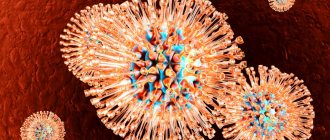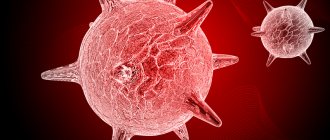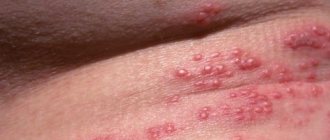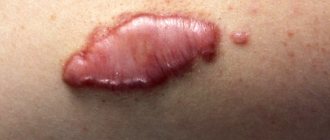Author: Datsenko S.A., infectious disease specialist. April, 2022.
Synonyms: herpes zoster. ICD-10 codes: B02.0-B02.9.
Shingles is an infectious disease caused by the herpes virus type 3. The main symptom is a blistering rash on any part of the body, accompanied by pain of varying intensity. Treatment is taking antiviral, painkillers, and vitamins.
Herpes zoster, also known as herpes zoster, is an acute infectious disease caused by the third type of herpes virus. The same virus is the cause of chickenpox. People get herpes zoster, like chickenpox, once in a lifetime. Repeated cases are extremely rare.
The main symptom of shingles is a blistering rash on the skin. It is similar to chickenpox, but is located in groups on certain areas of the body. Outwardly, this rash resembles a bunch of grapes. The rash is accompanied by acute pain, which persists even after the rash disappears.
Photo: rash characteristic of herpes zoster
Shingles most often occurs in people over 45 years of age; children and adolescents are less likely to get it. The disease has no seasonality; it occurs all year round.
Symptoms of herpes
Any rash on the body can be herpes, even if it appears on closed areas of the body. Especially often, herpetic rashes on the skin appear in people involved in martial arts - wrestlers, judokas, mixed martial arts fighters. A photo of the herpes virus on the wrestler’s lips is shown above.
How to distinguish herpes from stomatitis?
Many patients try to find an answer on the Internet to the question: “Do I have stomatitis or herpes? How to recognize? Herpes stomatitis can be easily distinguished from ordinary stomatitis by 3 key signs.
- With herpes infection, the rash is localized in the gum area. Whereas with stomatitis - on the soft tissues of the oral cavity (tongue, cheeks).
- A herpes rash first appears as blisters, which then ulcerate, while stomatitis begins with the appearance of ulcers.
- Herpetic stomatitis is characterized by a stable appearance of the rash in the same places, and with ordinary stomatitis its location often changes.
Characteristics of the virus
The frequency of infection is due to the fact that the herpes virus initially lives inside the human body, waiting for the right moment to manifest itself externally. The opportunity to look at photos of herpes in the mouth, hands, lips and even eyes appears as soon as the immune system weakens or direct infection with the virus occurs from another carrier.
It's all the virus's fault!
The term "stomatitis" is derived from the merger of two Greek words: stoma (mouth) and itis (inflammation). There are a great variety of different types of disease - serous, aphthous, allergic, etc. The most dangerous is herpetic, or cold sore, stomatitis caused by a virus. Its main manifestations are painful ulcers covering the oral mucosa. The trigger mechanism of the disease is the activation of herpes simplex virus types 1 and 2. First of all, the disease threatens those who have a weakened immune system and, as a result, the body simply does not have the strength to give a worthy rebuff to viruses.
Necessary treatment
From the photo of what herpes is, it is clear that you should not let the infection take its course. Manifestations of herpes need to be treated. For this you can use ointments Fenistil, Acyclovir and other topical antiviral drugs. Above you will see photographs of herpes on the face, namely manifestations in the eyes.
Causes of herpes stomatitis
There are two types of herpetic stomatitis: acute and chronic. Acute herpetic stomatitis, according to Dr. Komarovsky, occurs only in children under 3 years of age, when for the first time the child’s body, already deprived of antibodies to the herpes virus received from the mother, is first exposed to a viral attack from the outside. Moreover, the source of infection, as a rule, is the parents themselves - carriers of the virus, who kiss the baby or lick his pacifier or feeding spoon.
Recurrent or chronic stomatitis is already the lot of adults. The disease is recurrent in nature as soon as the body’s immune forces are weakened. In this case, primary infection can occur either through airborne droplets (sneezing), or through household contact (for example, through the use of the same dishes with a virus carrier) or hematogenous (through blood during injections, etc.). The incubation period of the disease can last up to two weeks depending on the state of the immune system.
Attention!
The pathogenesis of the disease in dentistry is still unknown. But if the body is weakened, any injury to the palate or gums can provoke activation of the herpes virus types 1 and 2!
Screening for herpes zoster
Diagnosis of shingles is not difficult, since the rash has a very characteristic appearance. The fact of chickenpox suffered in childhood and the presence of provoking factors are important.
To confirm atypical forms:
- blood for antibodies to the herpes virus type 3 - class M antibodies (igM) appear;
- blood test using PCR method - the virus itself is detected;
- general blood test - the number of leukocytes increases mainly due to lymphocytes, the ESR increases.
To diagnose complications in the brain, computed tomography or magnetic resonance imaging is performed.
Causes and risk factors
The cause of shingles is the third type of herpes virus. This virus causes chickenpox. Chickenpox usually affects children; the disease is rare in adults. After chickenpox, the virus remains in the body for life.
It moves to the nerve ganglia, where it remains in an inactive state for a long time, without causing any symptoms. When the body weakens and is exposed to provoking factors, the virus becomes more active. It reaches the skin along the nerve fibers, where a rash forms. Moving along the nerve fibers, the virus destroys them, which is why pain occurs.
You cannot get shingles from another person. The disease will only occur if a person has had chickenpox and the virus remains in his body. Shingles is not transmitted by airborne droplets. But there is one nuance here. A person with shingles is dangerous to people who have not had chickenpox.
If a person with shingles comes into contact with a person who has not had chickenpox, the latter will develop chickenpox. But here you need quite close contact. The virus in lichen is found only in the skin and is not spread by airborne droplets.
Reasons for the activation of the virus:
- a sharp decrease in immunity - after a serious illness, with cancer, HIV infection;
- severe or frequent overheating - visiting a bathhouse or sauna, climate change;
- hypothermia;
- prolonged exposure to the sun or solarium;
- severe stress.
Shingles reoccurs extremely rarely. Relapses can occur in people with active autoimmune diseases or HIV infection without taking antiretroviral drugs. Repeated cases also occur in people with cancer, and the rash often corresponds to the location of the tumor. There is no chronic form of herpes zoster; this disease is always acute.
Shingles is classified according to the nature of its course:
- typical;
- atypical.
According to severity:
- light;
- moderate severity;
- heavy.
There are fulminant and protracted course of the disease. Shingles also occurs with or without complications.
Causes of herpetic rashes
Natural tears protect the visual organ well from viruses if there are no violations. Immunoglobulins contained in tear fluid block the spread of infection.
Causes of herpetic rashes:
- weakened immunity due to a stressful situation, infectious pathologies, hypothermia;
- injuries to the visual organ;
- pregnancy;
- use of immunosuppressants.
Important! You can become infected with ophthalmoherpes through contact with a source of infection (mucous mucous membranes of intimate organs, oral cavity), through household items (towels, personal hygiene items).
Symptoms
Shingles is an acute disease with pronounced symptoms. The disease develops in stages:
- primary signs;
- the height stage with characteristic rashes;
- stage of recovery, disappearance of rashes;
- stage of residual effects - postherpetic neuralgia.
The first manifestation is pain along the nerve fibers. It occurs due to the destruction of the nerve sheath by the virus. Pain occurs 24-72 hours before the rash appears, so some other disease may be suspected first. For example, if pain appears in the area of the shoulder blades, a person will think of intercostal neuralgia. Pain in the right side is masked as an attack of cholecystitis. The pain is quite specific - it seems that the skin hurts.
By the third day, the main symptoms of herpes zoster appear. In most cases, the sick person’s temperature rises to 38 degrees, and they experience malaise and body aches. A blistering rash forms on the area of the skin where the pain occurred. It is similar to the chickenpox rash, but is not located chaotically, but is grouped. The rash runs along the nerve fibers in a wide stripe. This is where the name of the disease comes from - the rash seems to encircle an area of the body.
Photo: one of the options for localizing a rash with herpes zoster.
Herpes zoster can occur on any part of the body:
- the most common location is the back and ribs;
- buttocks, thighs;
- shoulders;
- face and scalp.
Rashes are rarely localized on the abdomen, neck, groin area and mucous membranes. In the area of the rash, the lymph nodes become enlarged. If the rash is localized on the face or in the eye area, the mucous membrane and cornea are affected.
After 5-7 days, the bubbles burst and become crusty. Within 10-14 days, this crust disappears, leaving no scars. Darkening of the skin remains at the site of the rash for several days.
Itching is not typical for the rash, unlike chickenpox. With shingles, the affected area of the skin becomes numb, and at the same time the person experiences pain. The intensity of pain can vary - from mildly noticeable to unbearable. The pain intensifies in the evening and at night.
Atypical course of herpes zoster is rare. In this case, the body temperature can remain normal, there is no pronounced pain syndrome. Rashes are scanty or completely absent. In people with HIV infection, on the contrary, a more aggressive course of the disease is observed. The rashes fester, the skin in this area dies. Sometimes the bubbles merge and form several large bubbles called bullae.
Some patients develop postherpetic neuralgia 3-4 weeks after recovery. These are pain sensations that occur along the affected nerve. The pain is quite intense and intensifies at night, after overheating or hypothermia. The duration of postherpetic neuralgia ranges from 3 to 12 months. The maximum recorded period of neuralgia is three years.
Postherpetic neuralgia often develops in older people, patients with concomitant chronic diseases, and immunodeficiency. You can suspect the risk of developing neuralgia if unbearable pain appears from the very beginning of the disease.
What can be confused with
Herpes zoster has a unique clinical picture and must be distinguished from a small number of diseases.
Similar grouped rashes occur with zosteriform herpes simplex. It develops in people with weakened immune systems. But there is no such pronounced pain, numbness of the affected area of the skin. This is where itching comes to the fore.
The bullous form of herpes zoster with large confluent blisters should be distinguished from the bullous form of erysipelas. With erysipelas, there is pronounced swelling and tension of the skin; it is most often localized on the legs and face.
Large blisters on the skin appear in patients with HIV infection, diabetes mellitus, and cancer. There is no increase in temperature or severe pain.










